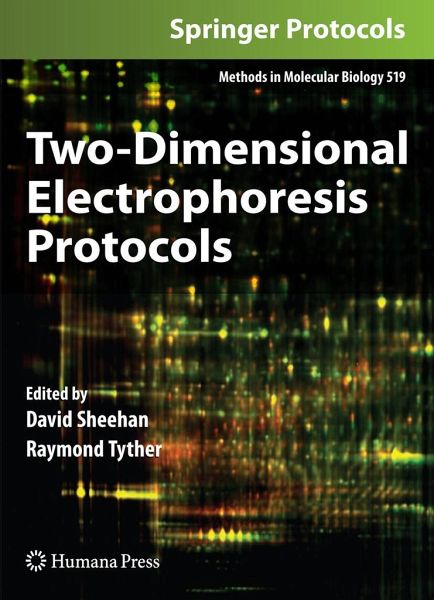Nicht lieferbar

Two-Dimensional Electrophoresis Protocols
Versandkostenfrei!
Nicht lieferbar
Two-dimensional electrophoresis (2-DE) remains one of the most popular techniques for proteomic comparisons. Revolutionized by the development of immobilized pH gradient strips, this vital process has benefited greatly from recent developments in staining, mass spectrometry, and bioinformatics. In Two-Dimensional Electrophoresis Protocols, expert researchers examine these cutting edge proteomics methodologies, explore their application to a wide range of biological materials, and look at how these developments have helped standardize the design, execution, and analysis of proteomics experiments. Chapters reflect key steps in 2-DE experiments, including sample preparation, staining, post-translational modification, spot identification, and bioinformatics. Composed in the highly successful Methods in Molecular Biology series format, each chapter contains a brief introduction, step-by-step methods, a list of necessary materials, and a Notes section which shares tips on troubleshooting and avoiding known pitfalls.
Innovative and reader-friendly, Two-Dimensional Electrophoresis Protocols encourages newcomers to apply powerful 2-DE techniques to their own research, while also providing current and essential information for seasoned scientists.
Innovative and reader-friendly, Two-Dimensional Electrophoresis Protocols encourages newcomers to apply powerful 2-DE techniques to their own research, while also providing current and essential information for seasoned scientists.
The human genome and other large-scale genome sequencing projects have inevitably led to a focus on the proteins encoded by genes. The field of proteomics has grown enormously as a result and a number of high-throughput technologies have now been developed allowing discovery-led investigations of protein populations rather than more traditional hypothesis-led studies on single proteins. These high-throughput techno- gies include gene and protein microarrays, the yeast two-hybrid system, and various mass spectrometry methodologies. However, despite developments and improvements in these technologies, two-dimensional electrophoresis (2DE) remains one of the most widely used approaches. This technique was revolutionised by the development of immobilised pH gradient strips which are now commercially available. This has made possible highly reproducible separations of matched samples. Developments in staining, mass spectr- etry, and bioinformatics supported these developments and haveled to a measure of standardisation in design, execution, and analysis of proteomics experiments. This book began life as a proposed update of the excellent volume 2DE Protocols edited by Andrew Link of the University of Washington at Seattle. However, we re- ised that 2DE has undergone major development in aspects of its technology in recent years and we were anxious to reflect these in the present volume. We are also conscious that many researchers have now begun to apply proteomics methodologies to a growing range of biological material and we were anxious to include contributions to reflect the challenges posed in sample preparation in less widely used organisms.



